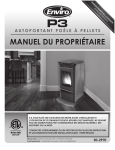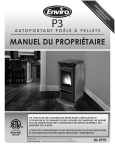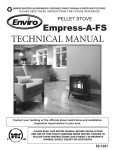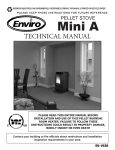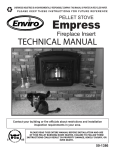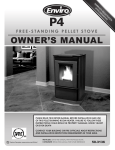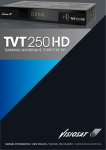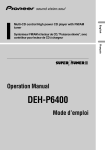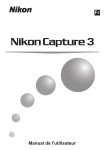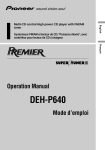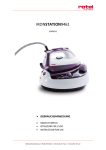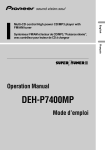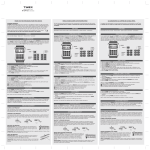Download Enviro EF5-DIAL-A-FIRE Specifications
Transcript
21 7, 5$ W\ 6 7 DQ *, DUU 5( Z < P 17 FR 5$ LUR $5 Y : HQ 0 ) 5 ( ( 6 7 $ 1 ' , 1 * 3 ( / / ( 7 6 7 2 9 ( 3/($6(5($'7+,6(17,5(0$18$/%()25(,167$//$7,21$1'86( 2)7+,63(//(7%851,1*5220+($7(5)$,/85(72)2//2:7+(6( ,16758&7,216&28/'5(68/7,13523(57<'$0$*(%2',/<,1-85< 25(9(1'($7+ &217$&7<285%8,/',1*25),5(2)),&,$/6$%2875(675,&7,216 $1',167$//$7,21,163(&7,215(48,5(0(176,1<285$5($ ,167$//(5/($9(7+,60$18$/:,7+7+(:22'6729( &21680(55(7$,17+,60$18$/)25)8785(5()(5(1&( Version française: www.enviro.com/fr 1 Table of Contents Introduction...................................................................................................................3 Important Safety Data........................................................................................................3 Safety Warnings And Recommendations..............................................................................4 Rating Label Location.........................................................................................................6 Pellet Quality......................................................................................................................6 Installation.......................................................................................................................7 Deciding Where to Locate the Appliance............................................................................7 Unpacking and Removing Pellet Stove From Pallet..............................................................7 Clearances to Combustibles................................................................................................9 Alcove Clearances...............................................................................................................9 Vent Termination Requirements.........................................................................................10 Outside Fresh Air Connection...........................................................................................11 Exhaust and Intake Locations...........................................................................................11 Mobile Home Installation..................................................................................................12 Corner Through Wall Installation.......................................................................................12 Horizontal Exhaust Through Wall Installation....................................................................13 Through Wall Vertical Rise Horizontal Termination - Freestanding.......................................14 Inside Vertical Installations................................................................................................15 Outside Vertical Installations..............................................................................................15 Hearth Mount Installation................................................................................................16 Exterior Mounted Exhaust Blower....................................................................................17 Through Wall with Exterior Blower Kit Installation - Horizontal Termination.........................18 Through Wall with Exterior Blower Kit Installation - Vertical Termination.........................19 Thermostat Installation.....................................................................................................19 Specifications.......................................................................................................................20 Dimensions and Specifications...........................................................................................20 Operating Instructions..................................................................................................................21 Control Board Functions....................................................................................................21 Automatic Safety Features of Your Pellet Stove...................................................................21 Operating Your Pellet Stove...............................................................................................22 Turning Your Pellet Stove Off..............................................................................................22 Damper Set-Up.................................................................................................................22 Guidelines For Fine-Tuning For Fuel Quality........................................................................23 Routine Cleaning and Maintenance................................................................................................24 Troubleshooting.................................................................................................................28 Wiring Diagram...........................................................................................................................31 Parts List.....................................................................................................................................32 Parts Diagram..............................................................................................................................34 Rating Label................................................................................................................................36 Warranty..................................................................................................................37 2 Installation Data Sheet...............................................................................................................38 Introduction IMPORTANT SAFETY DATA: Please read this entire Owner’s Manual before installing or operating your ENVIRO Pellet Stove. Failure to follow these instructions may result in property damage, bodily injury or even death. Any unauthorized modification of the appliance or use of replacement parts not recommended by the manufacturer is prohibited. Contact your local building or fire official to obtain a permit and any information on installation restrictions and inspection requirements for your area. All local regulations, including those referring to national and European Standards need to be complied with when installing this appliance. To prevent the possibility of a fire, ensure that the appliance is properly installed by adhering to the installation instructions. An ENVIRO dealer will be happy to assist you in obtaining information with regards to your local building codes and installation restrictions. The stove’s exhaust system works with negative combustion chamber pressure and a slightly positive chimney pressure. It is very important to ensure that the exhaust system be sealed and airtight. The ash pan and viewing door must be locked securely for proper and safe operation of the pellet stove. Do not burn with insufficient combustion air. A periodic check is recommended to ensure proper combustion air is admitted to the combustion chamber. Setting the proper combustion air is achieved by adjusting the slider damper located on the left side of the stove. When installing the stove in a mobile home, it must be electrically grounded to the steel chassis of the home and bolted to the floor. Make sure that the structural integrity of the home is maintained and all construction meets local building codes. Consider all large air moving devices when installing your unit and provide room air accordingly. NOTE: Extractor fans when operating in the same room or space as the appliance, may cause problems. Limited air for combustion may result in poor performance, smoking and other side effects of poor combustion. Minor soot or creosote may accumulate when the stove is operated under incorrect conditions such as an extremely rich burn (black tipped, lazy orange flames). Be sure to maintain the structural integrity of your home when passing a vent through walls, ceilings, or roofs. It is recommended that the unit be secured into its position in order to avoid any displacement. This appliance must be installed on a floor with an adequate load bearing capacity. If an existing construction doesn’t meet these prerequisite, suitable measures (e.g. load distributing plate) shall be taken to achieve it. FRESH AIR: Outside Fresh Air connection is optional. Fresh Air must be connected to all units installed in Mobile Homes and Air Tight Homes (R2000) or where required by local codes. If you have any questions with regards to your stove or the above-mentioned information, please feel free to contact your local dealer for further clarification and comments. 3 Introduction SAFETY WARNINGS AND RECOMMENDATIONS: Caution: Do not connect to any air distribution duct or system. Do not burn garbage or flammable fluids such as gasoline, naphtha or engine oil. Unit hot while in operation. Keep children, clothing and furniture away. Contact may cause skin burns. Warning: Parts of the appliance, especially the external surfaces, will be hot to touch when in operation and due care will need to be taken. Never place wood, paper, furniture, drapes or other combustible materials within 80cm (31½”) of the front of the unit, 20cm (7⅞”) from each side, and 10cm (4”) from the back of the unit. Do not let children or pets touch it when it is hot. To prevent the possibility of a fire, ensure that the appliance is properly installed by adhering to the installation instructions. An ENVIRO dealer will be happy to assist you in obtaining information with regards to your local building codes and installation restrictions. FIRE EXTINGUISHER AND SMOKE DETECTION: All homes with a pellet burning stove should have at least one fire extinguisher in a central location known to all in the household. Smoke detectors should be installed and maintained in the room containing the stove when installing and operating a pellet burning appliance. If it sounds the alarm, correct the cause but do not deactivate. You may choose to relocate the smoke detection devise within the room; DO NOT REMOVE THE SMOKE DETECTOR FROM THE ROOM. CHIMNEY OR RUN AWAY FIRE: Call local fire department (or dial 911). Close the draft fully. Examine the flue pipes, chimney, attic, and roof of the house, to see if any part has become hot enough to catch fire. If necessary, spray with fire extinguisher or water from the garden hose. IMPORTANT: Do not operate the stove again until you are certain the chimney and its lining have not been damaged. FUEL: This pellet stove is designed and approved to only burn wood pellet fuel with up to 3% ash content. Dirty fuel will adversely affect the operation and performance of the unit and may void the warranty. Check with your dealer for fuel recommendations. THE USE OF CORD WOOD IS PROHIBITED BY LAW. SOOT: Operation of the stove with insufficient combustion air will result in the formation of soot which will collect on the glass, the heat exchanger, the exhaust vent system, and may stain the outside of the house. This is a dangerous situation and is inefficient. Frequently check your stove and adjust the slider/ damper as needed to ensure proper combustion. See: “DAMPER SET-UP”. CLEANING: There will be some build up of fly ash and small amounts of creosote in the exhaust. This will vary due to the ash content of the fuel used and the operation of the stove. It is advisable to inspect and clean the exhaust vent semi-annually or every two tons of pellets. ASHES: Disposed ashes should be placed in a metal container with a tight fitting lid. The closed container of ashes should be on a non-combustible floor on the ground, well away from all combustible materials pending final disposal. If the ashes are disposed of by burial in soil or otherwise locally dispensed, they should be retained in the closed container until all cinders have been thoroughly cooled. ELECTRICAL: The use of a surge protected power bar is recommended. The unit must be grounded. The grounded electrical cord should be connected to a standard 110-120 volts, nominal average 2.0 Amps (4.1 Amps peak), 60 hertz electrical outlet and also must be accessible. Ensure the polarity to the outlet the unit will be plugged into is correct as incorrect polarity can affect the unit’s 4 Introduction operation. If this power cord should become damaged, a replacement power cord must be purchased from the manufacturer or a qualified ENVIRO dealer. Be careful that the electrical cord is not trapped under the appliance and that it is clear of any hot surfaces or sharp edges. This unit’s maximum power requirement is 184 watts (600 watts peak). GLASS: Do not abuse the glass by striking or slamming the door. Do not attempt to operate the stove with broken glass. The stove uses ceramic glass. Replacement glass must be purchased from an ENVIRO dealer. Do not attempt to open the door and clean the glass while the unit is in operation or if glass is hot. To clean the glass, use a soft cotton cloth and mild window cleaner, gas or wood stove glass cleaner, or take a damp paper towel and dip into the fly ash. This is a very mild abrasive and will not damage the glass. FLAMMABLE LIQUIDS: Never use gasoline, gasoline-type lantern fuel, kerosene, charcoal lighter fluid, or similar liquids to start or “freshen up” a fire in the heater. Keep all such liquids well away from the heater while it is in use. SMOKE DETECTOR: Smoke detectors should be installed and maintained in the structure when installing and operating a pellet burning appliance. OPERATION: The ash pan and door must be closed securely for proper and safe operation of the pellet stove. Also ensure all gaskets on the door are checked and replaced when necessary. KEEP ASH PAN FREE OF RAW FUEL. Do not lace unburnt fuel or new fuel in ash pan. A fire in the ash pan may occur. INSTALLATION: Be sure to maintain the structural integrity of your home when passing a vent through walls, ceilings, or roofs. It is recommended that the unit be secured into its position in order to avoid any displacement. DO NOT INSTALL A FLUE DAMPER IN THE EXHAUST VENTING SYSTEM OF THIS UNIT. DO NOT CONNECT THIS UNIT TO A CHIMNEY FLUE SERVING ANOTHER APPLIANCE. FRESH AIR: Outside Fresh Air connection is optional. Must be connected to all units installed in Mobile and “Air Tight Homes” (R2000) or where required by local codes. Consider all large air moving devices when installing your unit and provide fresh air accordingly. Limited air for combustion may result in poor performance, smoking and other side effects of poor combustion. If you have any questions with regards to your stove or the above-mentioned information, please feel free to contact your local dealer for further clarification and comments. SINCE SHERWOOD INDUSTRIES LTD. HAS NO CONTROL OVER THE INSTALLATION OF YOUR STOVE, SHERWOOD INDUSTRIES LTD. GRANTS NO WARRANTY IMPLIED OR STATED FOR THE INSTALLATION OR MAINTENANCE OF YOUR STOVE. THEREFORE, SHERWOOD INDUSTRIES LTD. ASSUMES NO RESPONSIBILITY FOR ANY CONSEQUENTIAL DAMAGE(S). SAVE THIS INSTRUCTION MANUAL FOR FUTURE REFERENCE 5 Introduction RATING LABEL LOCATION: The rating label is located on the back of the ash pan access cover. PELLET QUALITY: Pellet quality is important, please read the following: Your Enviro pellet stove has been designed to burn wood pellets only. Do not use any other type of fuel, as this will void any warranties stated in this manual. The performance of your pellet stove is greatly affected by the type and quality of wood pellets being burned. As the heat output of various quality wood pellets differs, so will the performance and heat output of the pellet stove. CAUTION: It is important to select and use only pellets that are dry and free of dirt or any impurities such as high salt content. Dirty fuel will adversely affect the operation and performance of the unit and will void the warranty. Pellet Fuel Industries (P. F. I.) has established standards for wood pellet manufacturers. We recommend the use of pellets that meet or exceed these standards. Ask your dealer for a recommended pellet type. P. F. I. PELLET STANDARDS: Fines (fine particles)......1% maximum through a ⅛” screen Bulk Density..................40 pound per cubic foot minimum Size..............................¼” to 5/16” diameter ½ – 1½” long maximum Ash Content..................1% maximum (Premium grade) ..................3% maximum (Standard grade) Moisture Content...........8% maximum Heat Content.................approximately 8200 BTU per pound minimum ASH: The ash content of the fuel and operation of your stove will directly determine the frequency of cleaning. The use of high ash fuels may result in the stove needing to be cleaned daily. A low ash fuel may allow longer intervals between cleaning. CLINKERING: [clinkers are silica (sand) or other impurities in the fuel that will form a hard mass during the burning process]. This hard mass will block the air flow through the Burn Pot Liner and affect the performance of the stove. Any fuel, even approved types, may tend to clinker. Check the Burn-Pot Liner daily to ensure that the holes are not blocked with clinkers. If they become blocked, remove the liner (when the unit is cold) and clean/scrape the clinkers out. Clean the holes with a small pointed object if required. Refer to the section Routine Cleaning and Maintenance. PELLET FEED RATES: Due to different fuel densities and sizes, pellet feed rates may vary. This may require an adjustment to the slider damper setting or to the auger feed trim setting on low. Since Sherwood Industries Ltd. has no control over the quality of pellets that you use, we assume no liability for your choice in wood pellets. Store pellets in a dry area at least 36” (1 m) away from the pellet stove. 6 Installation DECIDING WHERE TO LOCATE YOUR PELLET APPLIANCE: 1. Check the “Clearances to Combustibles” section for proper spacing. 2. Do not obtain combustion air from an attic, garage or any unventilated space. Combustion air may be obtained from a ventilated crawlspace. 3. Do not install the stove in a bedroom. 4. You can vent the stove through an exterior wall behind the unit or connect it to an existing masonry or metal wood stove chimney (must be lined if the chimney is over 6” (15 cm) diameter, or over 28 inches² (180 cm²) cross sectional area). An interior vent can be used with approved pipe passing through the ceiling and roof. 5. Locate the stove in a large and open room that is centrally located in the house. This will optimize heat circulation. 6. The power cord is 8 feet (2.43 m) long and may require a grounded extension cord to reach the nearest electrical outlet. 7. Stove must sit on a non-combustible pad that extends six inches in front of the door or the included hearth pad (50-2929). UNPACKING AND REMOVING PELLET STOVE FROM PALLET 1. Start by removing the crating and unit bag, you will need a pry bar and hammer to remove the crating. A sawzall can be used to cut the staples as well. 2. Loosen six screws securing Back Grill, once loose slide downwards and remove. 3. Use a 5/16” wrench or socket to remove the shipping bolts holding the unit to the pallet. Remove Figure 1: Shipping Bolt Removal 7 Installation ASSEMBLY 1. First install the hearth pad if you plan on using it. You may have to unscrew feet to raise unit up. Tilt the unit so it is balancing on the back feet, slide the hearth pad under the unit while making sure the side mounting tabs are on the outside of the base flange. once holes are aligned secure with provided T-20 thread rolling screws. See Figure 2. Figure 2: Hearth Pad Install 2. Next install the Cabinet Sides. There are six screws for mounting each cabinet side. Start by installing screws at front top of the panels, Do not fully tighten screws. Now get the back top screws started. Now install the rest of the screws and tighten them down. See Figure 3. Figure 3: Cabinet Side Install 3. Now Install Ash Shelf and Louvers. Ash Shelf is mounted using two T-20 thread roller screws. The Louvers are installed by inserting into slots cut into louver moutning brakets located above the door. If properly aligned the louvers should catch on the bracket tabs and sit at a 15 degree angle. 8 Figure 4: Louver and Ash Shelf Install Installation CLEARANCES TO COMBUSTIBLES: IMPORTANT: The P3 must have a Hearth Pad when installing the unit on a combustible floor. The included hearth pad meet all the requirement of a proper hearth pad. If you do not use the included hearth pad a non combustible material must be placed underneath the unit and extend six inches in front of the unit measured from the door.If the P3 is installed on carpet the use of a solid non combustible material must be used under leveling legs. Back Wall 4in (10cm) ac dj A (7 Side Wall 8in (20cm) in l3 al tW en These dimensions are minimum clearances but it is recommended that you ensure sufficient room for servicing, routine cleaning and maintenance. ) m c .5 Side wall to unit 8 inches (20 cm) Back wall to unit 4 inches (10 cm) Corner to unit 3 inches (7.5 cm) Hearth Pad 6 inches (15 cm) Hearth Pad 6in (15cm) Figure 5: Minimum Install Clearances ALCOVE CLEARANCES: The unit may be installed in an alcove if desired. These minimum clearances to combustibles must be maintained at all times. Be sure to leave room for servicing, routine cleaning, and maintenance. These are inside dimensions. Minimum Alcove Width 36 inches (91.5 cm) Minimum Alcove Height 48 inches (122 cm) Minimum Alcove Depth 30 inches (76 cm) 36in (91.5 cm) 30in (76 cm) 48in (122 cm) Figure 6: Minimum Alcove Clearances 9 Installation VENT TERMINATION REQUIREMENTS: IT IS RECOMMENDED THAT YOUR PELLET STOVE BE INSTALLED BY AN AUTHORIZED DEALER/INSTALLER. Table 1: Use in conjunction with Figure 6 for allowable exterior vent termination locations. Letter Minimum Clearance Description A 24 in (61 cm) B 48 in (122 cm) Above grass, top of plants, wood, or any other combustible materials. Beside/below any door or window that may be opened. (18” (46 cm) if outside fresh air installed.) C 12 in (30 cm) Above any door or window that may be opened. (9” (23 cm) if outside fresh air installed.) D 24 in (61 cm) To any adjacent building, fences and protruding parts of the structure. E 24 in (61 cm) Below any eave or roof overhang F 12 in (30 cm) To outside corner. G 12 in (30 cm) To inside corner, combustible wall (vertical and horizontal terminations). H 3 ft (91 cm) within a height of 15 ft (4.5 m) above the meter/regulator assembly I 3 ft (91 cm) J 12 in (30 cm) Clearance to non-mechanical air supply inlet to building, or the combustion air inlet to any appliance. K 24 in (61 cm) Clearance above roof line for vertical terminations. L 7 ft (2.13 m) Clearance above paved sidewalk or paved driveway located on public property. 1. Do not terminate the vent in any enclosed or semi-enclosed areas such as a carport, garage, attic, crawlspace, narrow walkway, closely fenced area, under a sun deck or porch, or any location that can build up a concentration of fumes such as stairwells, covered breezeway, etc. To each side of center line extended above natural gas or propane meter/ regulator assembly or mechanical vent. From any forced air intake of other appliance G K E D B Opens F Opens B G C G I Opens L A 2. Vent surfaces can become H Termination Cap hot enough to cause burns Restriction Zone G Gas Meter Air Supply Inlet (Termination not allowed) if touched by children. Noncombustible shielding or guards Figure 7: Use in conjunction with Table 1 for allowable exterior vent termination locations. may be required. 3. Termination must exhaust above the inlet elevation. It is recommended that at least five feet of vertical pipe be installed outside when the appliance is vented directly through a wall, to create some natural draft to prevent the possibility of smoke or odor during appliance shut down or power failure. This will keep exhaust from causing a nuisance or hazard from exposing people or shrubs to high temperatures. In any case, the safest and preferred venting method is to extend the vent through the roof vertically. 4. Distance from the bottom of the termination and grade is 12” (30 cm) minimum. This is conditional upon the plants and nature of grade surface. The exhaust gases are hot enough to ignite grass, plants and shrubs located in the vicinity of termination. The grade surface must not be lawn. 5. If the unit is incorrectly vented or the air to fuel mixture is out of balance, a slight discoloration of the exterior of the house might occur. Since these factors are beyond the control of Sherwood Industries Ltd, we grant no guarantee against such incidents. NOTE: Venting terminals shall not be recessed into walls or siding. 10 Installation OUTSIDE FRESH AIR CONNECTION: Outside fresh air is mandatory when installing this unit in airtight homes (R2000) and mobile homes. A Fresh-air intake is strongly recommended for all installations. Failure to install a fresh air intake may result in improper combustion as well as the unit smoking during power failures. When connecting to an outside fresh air source, do not use plastic or combustible pipe. A 2” minimum (51 mm) ID (inside diameter) steel, aluminum or copper pipe should be used. It is recommended, when you are installing a fresh air system, to keep the number of bends in the pipe to a minimum. Outside Wall 2" ID (51 mm) Optional Elbow Figure 8: Outside Air Connection. EXHAUST AND INTAKE LOCATIONS: EXHAUST Base of unit to center of flue 10.5 in (265 mm) Center of unit to center of flue 0 in (0 mm) [at center of unit] FRESH AIR INTAKE. Base of unit to center of intake 6.625 in (170 mm) Center of unit to center of intake 2.125 in (53 mm) 10.5in (26.5 cm) 6.625in (17 cm) 2.125 in (5.5 cm) Figure 9: P3 Inlet and Outlet Location. 11 Installation MOBILE HOME INSTALLATION: ● Secure the heater to the floor using the two holes in the pedestal. ● Ensure the unit is electrically grounded to the chassis of your home (permanently). ● Do not install in a room people sleep in. ● Outside fresh air is mandatory. Secure outside air connections directly to fresh air intake pipe and secure with three screws evenly spaced. CAUTION: THE STRUCTURAL INTEGRITY OF THE MANUFACTURED HOME FLOOR, WALL AND CEILING/ ROOF MUST BE MAINTAINED. ENVIRO P3 Hearth Pad Flooring Steel Frame 1/4” Lag Bolts Securely Fastened CORNER THROUGH WALL INSTALLATION: Ground Wire Directly to Metal Chassis Figure 10: Mobile home installation. Minimum clearances must be maintained for a corner installation as shown in figure 11. 3" (75mm) Wall thimble manufactured by pellet vent manufacturer. 3" (75mm) Figure 11: Corner Installation. 12 Installation HORIZONTAL EXHAUST THROUGH WALL INSTALLATION: Vent installation: install vent at clearances specified by the vent manufacturer. A chimney connector shall not pass through an attic or roof space, closet or similar concealed spaces, or a floor, or ceiling. Where passage through a wall or partition of combustible construction is desired, the installation shall conform to CAN/CSA-B365 Installation Code for Solid-Fuel-Burning Appliances and Equipment. Only use venting of L or PL type with an inside diameter of 3 or 4 inches (7.6 or 10.1 cm). 1. Choose a location for your stove that meets the requirements stated in this manual and allows installation with the least amount of interference to house framing, plumbing, wiring, etc. Wall thimble 4" (10 cm) 12" (30.5 cm) 2. Install a non-combustible hearth pad (where necessary). 3. Place the appliance 15” (37.5 cm) away from the wall. If the stove is to be set on a hearth pad, set the unit on it, and adjust the leveling legs. 4. Locate the center of the exhaust pipe on the stove. Extend that line to the wall. Once you have located the center point on the wall, refer to pellet vent manufacturer installation instructions for correct hole size and clearance to combustibles. 5. Install the wall thimble as per the instructions written on the thimble. Maintain an effective vapour barrier in accordance with local building codes. 6" (15 cm) 45° elbow Non-combustible floor protection. Existing floor (combustible) Figure 12: Straight through wall Installation. 6. Install a length of 3” (75 mm) or 4” (100 mm) vent pipe into the wall thimble. The pipe should install easily into the thimble. 7. Connect the exhaust vent pipe to the exhaust pipe on the stove. Seal the connection with high temperature silicone. Exhaust Tube 3" (75mm) or 4" (100mm) "PL" or "L" vent 8. Push the stove straight back, leaving a minimum of 4” (10 cm) clearance from the back of the stove to the wall. Seal the vent pipe to the thimble with high temperature silicone. 9. The pipe must extend at least 12” (30 cm) away from the building. If necessary, bring another length of pipe (PL type) to the outside of the home to connect to the first section. Do not forget to place high temperature silicone around the pipe that passes through the thimble. Wall Thimble Fresh Air Intake Tube 45° Elbow with screen or Termination Cap High Temperature RTV Silicone Required Figure 13: Venting to use with straight through wall Installation. 13 Installation 10. Install a vertical pipe, or if all requirements for direct venting are met, install vent termination. The stainless steel cap termination manufactured by the vent manufacturer is recommended. However, when the vent terminates several feet above ground level and there are no trees, plants, etc. within several feet, a 45° elbow can be used as termination. The elbow must be turned down to prevent rain from entering. NOTE: • It is recommended that horizontal through wall installations have 3 to 5 feet (91 to 152 cm) of vertical pipe in the system to help naturally draft the unit in the event of extreme weather or a power outage. • Some horizontal through wall installations may require a “T” and 3 to 5 feet (91 to 152 cm) of vertical pipe outside the building to help draft the unit. This may be required if a proper burn cannot be maintained, after the stove has been tested and the airflow set. This is due to the back pressure in the exhaust caused by airflow around the structure. • Follow vent manufacturer guidelines for installation of venting. High temp sealant must be used when connecting vent pipe to the unit’s starter pipe. Improper seals at the vent joints may cause combustion by-products to leak into the room where installed - seal as required. THROUGH WALL VERTICAL RISE HORIZONTAL TERMINATION INSTALLATION - FREESTANDING: A termination cap is always recommended for this type of install but a stainless steel termination hood or a 45° elbow may be used in place of the cap. Figure 14 is the recommended installation set up, venting length is negligible. Figure 15 is the installation to use if there is a concrete or retaining wall in line with exhaust vent on a pellet stove. The termination must be 12” (30 cm) from the outside wall and 12” (30 cm) above the ground. Termination cap Horizontal frame for thimble 90° elbow Wall framing Termination cap Wall thimble 90° elbow Vertical section of vent pipe Vertical section of vent pipe Horizontal frame for thimble Wall strap Wall framing Concrete Wall Clean out tee Clean out tee Wall thimble Figure 14: Venting horizontally with rise. 14 Figure 15: Venting with concrete wall behind unit . Installation INSIDE VERTICAL INSTALLATIONS: Rain Cap (ensure cap is at least 3ft above the roof at the lowest point) 2 ft (600 mm) Roof Flashing Roof Rafter Fire Stop with Support Collar Ceiling Joist 1. Choose a stove location that is ideal. See the section “DECIDING WHERE TO LOCATE YOUR PELLET APPLIANCE.” 2. Place a non-combustible necessary. hearth pad where 3. Place the unit on the hearth pad (if installed on a combustible surface) and space the unit in a manner so when the pellet vent is installed vertically, it will be 3” (7.5 cm) away from a combustible wall. 4. Install the tee with clean out. Vertical Vent Pipe Clean Out Tee with Pipe Adapter NOTE: All vent sections must maintain 3 inches (7.5 cm) clearances to combustibles. 5. Install the pellet vent upward from there. When you reach the ceiling, make sure that the vent goes through the ceiling fire stop. Maintain a 3” (7.5 cm) distance to combustibles and keep attic insulation away from the vent pipe. Maintain an effective vapor barrier. 6. Finally, extend the pellet vent to go through the roof flashing. 7. Ensure that the rain cap is approximately 24” (600 mm) above the roof. Figure 16: Inside Vertical Installation. OUTSIDE VERTICAL INSTALLATIONS: To accomplish a outside vertical pipe installation, follow steps 1 through 5 in the “INSIDE VERTICAL INSTALLATIONS FREESTANDING” section and then finish it by performing the following (refer to Figure 17). Rain cap Flashing 24" (61 cm) 1. Install a tee with clean out on the outside of the house. 2. Install PL vent upward from the tee. Make sure that you install support brackets to keep the vent straight and secure. 3. Install ceiling thimble and secure the flashing as you go through the roof. 4. Ensure that the rain cap is approximately 24” (600 mm) above the roof. 3" (7.5 cm) Clearance 4" (10 cm) Support bracket Tee with cleanout Type "PL" vent Figure 17: Outside Vertical Installation. 15 Installation HEARTH MOUNT INSTALLATION: Damper Removed or Fastened Open 10" (25.4 cm) Mantel Minimum 8" (20 cm) from top of stove Flue Connector Clean-out tee Min 6" (150 mm) Optional Hearth or Other Floor Protection Masonry Fireplace Combustible Floor Figure 18: Freestanding hearth mount installation. Rain cap Storm collar Seal plate (cover plate) Existing masonry flue Vent pipe (single wall stainless flex pipe or solid PL vent) Flexible vent connector (use this 5 foot [152cm] section of pipe to vent past fireplace damper or small shelf) Fireplace damper location Clean out tee Existing fireplace 16 Figure 19: Freestanding hearth mount installation overview. Refer to Figures 18 and 19. 1. Install the hearth pad. 2. Lock the fireplace damper in the open position. 3. Install a positive flue connector at the fireplace dampers or seal the chimney at the top. 4. Connect a tee to the exhaust pipe. 5. Install flexible stainless steel liner or listed pellet vent to the top of the chimney. Installation EXTERIOR MOUNTED EXHAUST BLOWER (20-070): The P3 can be equipped with an externally mounted exhaust blower. This optional kit includes all components necessary to install the exhaust blower on any vertical wall surface. Choose a location for your stove that meets the requirements stated in your manual and allows installation with the least amount of interference with house framing, plumbing, wiring, etc. Make sure unit is unpluged. Included in the Exterior Mounted Exhaust Blower Kit are: 1 - Exhaust blower housing box. Figure 20: Exterior Blower Kit. 1 - Blower cover plate. 1 - Hardware bag 1. Remove the left hand cabinet side by removing the six mounting screws down the front. Loosen the three screws, slide the cabinet side forward and remove panel. 2. Loosen the six screws that hold the back grill in place. Lift the back grill off the screws. 3. Disconnect the Exhaust blower wires from the wire harness. Remove the exhaust blower motor from the housing; six screws. Cover hole in housing with cover plate provided (see Figure 21). Figure 21: Exterior Blower Kit. 4. Remove the cover from the exterior exhaust blower housing box. 5. Install the exhaust blower housing box into the pipe placed through the wall thimble, seal with high temperature silicone. Fasten the box to the wall with (4) four screws, seal edges of box to wall with clear silicone. 6. Drill a hole through the wall thimble plate for the electrical wires. Pass the armored cable through the wall thimble. Use the strain relief provided. Do not pass cable through vent hole. 7. Install the Exhaust Blower motor into the external exhaust blower housing box. Make the electrical connections to the wire harness and exhaust blower. 8. Replace the cover on the exterior Exhaust Box and the back grill of the stove and ensure the screws are tightened down. Figure 22: Exterior Blower Kit section view. 9. Install vertical pipe as instructed in appropriate section. 17 Installation THROUGH WALL WITH EXTERIOR BLOWER KIT INSTALLATION - HORIZONTAL TERMINATION: 90° Elbow 45°Elbow with Rodent screen or stainless steel termination hood 2ft (610mm) Riser Pipe Adaptor Exterior Blower and Housing Electrical Cable Figure 23: Through Wall Installation with Exterior Blower Kit. NOTE: Ensure that all interior vent connections are sealed by placing a small bead of high temperature silicone around each chimney connection. Also ensure that all vertical vent sections are properly supported and that all clearances to combustibles are maintained in accordance with the vent manufacturer’s specifications. Wall Strap To supply power to the exhaust blower Figure 24: Through Wall Installation with Exterior Blower Kit; Side View. Install the amour coated electrical cable from the exhaust blower housing, through the wall thimble plate and attach to the pre drilled hole in the left hand rear hopper pillar. Hook up to wires from the exhaust blower wiring harness. All electrical connections must be in accordance to local code requirements 18 Installation TYPICAL THROUGH WALL WITH EXTERIOR BLOWER KIT INSTALLATION - VERTICAL TERMINATION: Follow the previous pages for through wall installations. Ensure that vent pipe is properly secured to wall using wall straps. Maintain clearances to combustibles on vent pipe as well as unit. Roof Sheathing Rain Cap Roof Flashing Roof Rafters Ceiling Joists Vent Pipe Exterior Wall Sheathing Outside Vent Termination Figure 25: Through Wall Installation with Exterior Blower Kit; Vertical Termination. THERMOSTAT INSTALLATION: 1. Install the wall thermostat in a location that is not to close too the unit but will effectively heat the desired area. 2. The Right Cabinet Side will need to be removed to access the Control Board. Once the side has been removed you can remove three screws securing the Control Board Cover. 3. Now that the board can be accessed, wire the Thermostat using to the Control Board using an 18 gauge, 2 connector wire from the unit to the thermostat. Figure 26: Thermostat wire placement. 19 Specifications DIMENSIONS AND SPECIFICATIONS: 15 1/2" (389 mm) Weight (with full hopper): 275 lb (125 Kg) Hopper Capacity: up to 62 lb (28 Kg) Voltage: 110 - 120 V Max Current: 4.1 Amps Consumption on High: 3.1 lb/hr (1.4 Kg/hr)* Consumption on Low: 1.3 lb/hr (0.6 Kg/hr)* (Note: Consumption will vary with the type of fuel used.) 5 1/2" (143 mm) 20" (508 mm) 18" (460 mm) 35" (886 mm) 17 1/2" (444 mm) 20 1/2" (526 mm) UNLESS OTHERWISE SPECIFIED 20 24" (615 mm) Sherwood Industries Ltd. Figure 27: Dimensions of P3. Operating Instructions CONTROL BOARD FUNCTIONS: 1. POWER BUTTON: This is the green button with the power symbol, it is used to turn the unit on and off. When the power is on and the blue LED beside the button will be illuminated. The LED will flash during the start-up cycle. Once startup cycle is complete the power LED will stay on. 2. AUTO BUTTON: Located below the Power button, when pressed this activates Auto or “Comfort” mode. LED beside button will be illuminated when active. 3. THERMOSTAT BUTTON: Located below the Auto Button. This is for external thermostat control. LED beside button will be illuminated when active. 4. ARROW BUTTON: The Arrow Buttons are used to adjust heat level and trim settings. START-UP: When the unit is turned on it will go into a start-up cycle while trying to light a fire. During start-up you have no control over the settings. The Power LED will flash until start-up is complete. You can adjust heat levels or toggle the different modes during start-up but these adjustments will not come into affect until the start-up cycle is complete. Auto MANUAL MODE: Once the start-up cycle is completed you will be in either Manual mode or Auto mode. When in Manual mode the Power LED is illuminated and AUTO LED is not. Use the Arrow buttons to adjust heat level from L1-L5. AUTO MODE: Press the Auto button to activate Auto or “Comfort” mode. When activated the Power and Auto LED’s will be illuminated. Use the Arrow buttons to adjust from C1-C9. Each setting corresponds to a different temperature set point. The stove will automatically adjust to hold this temperature. As the room temperature gets close to the set point the fire will decrease in size. If room temperature is above the set point for a certain amount of time the stove will shut down and go into Suspend mode. Figure 28: Circuit Board Control Panel Decal. SUSPEND MODE: Once a stove has gone into Suspend mode the fire will go out. This means the room has heated up beyond the Auto set point. Once temperature in the room drops below the Auto set point the stove start back up and run until the room gets to hot once again. When in suspend mode the Auto LED will flash. THERMOSTAT MODE: This can only be used in Manual mode, and is for external thermostat control. A external thermostat can be wiring to the main control board. When activated the LED beside the Thermostat Button will be illuminated. FEED/COMBUSTION TRIM: To adjust the Feed Trim you must be in Manual mode heat level 1. Press the hidden button located under the down arrow. The Display will then change from P (Program) to A (Auger) to C (Combustion) with a two second delay between changes. When the display shows an A use the arrows to adjust the feed trim. To adjust the combustion fan trim wait until the display shows C then use the arrows to adjust. AUTOMATIC SAFETY FEATURES OF YOUR PELLET STOVE: A. The stove will shut off when the fire goes out and the exhaust temperature drops below 120°F (49°C). B. The stove has a high temperature safety switch. If the temperature on the hopper reaches 200°F (93°C), the auger will automatically stop and the stove will shut down. The LED display will show an E3 error cod, see Troubleshooting section. If this happens, call your local dealer to reset the 200°F (93°C) high limit switch. ALSO FIND THE REASONS WHY THE UNIT OVERHEATED. C) The unit is equipped with a vacuum switch to monitor the venting; if it becomes blocked the vacuum switch will turn off the auger and there will be an E2 error code on Th eLED Display. 21 Operating Instructions OPERATION YOUR PELLET STOVE: PRE-BURN INSTRUCTIONS: The burn pot liner holes must be clear and the liner installed properly against the ignitor tube for proper operation. Check the hopper for enough pellets to start the unit. DO NOT OPERATE THE UNIT WITH THE DOOR OR ASH PAN OPEN. TO START: Press the Power button. The stove will turn on. The LED beside the Power button will flash to indicate a start-up cycle. The Heat Level is shown on the LED display, you can change the Heat Level and mode but these adjustments will not take affect until the start-up cycle is complete. If this is the first time the unit has been started or the unit has run out of fuel, the auger will need to be primed. You may need restart the unit if an E3 error occurs, to do this just press the Power button again. Once you see pellets start to drop the auger is primed. TO OPERATE: When a fire has been established, the Power LED will turn solid (after approximately 10 - 15 minutes) the current settings will now take affect. The convection blower (room air blower) will turn on. The speed of this blower is automatically controlled and is based off the heat level setting. TURNING YOUR PELLET STOVE OFF: To turn off your Pellet stove just press the Power button. This will not shut off the stove instantly, it will take approximately 5 minutes for the fire to burn out. The fans will stay running until the unit has cooled sufficiently. NEVER unplug a unit that is running! DO NOT unplug unit while Combustion fan is running. Unplugging may cause smoke to be released into the home. DAMPER SET-UP: DAMPER MUST BE SET AT TIME OF INSTALLATION. This is used to regulate the airflow through the pellet stove, this is key to an efficient clean burn. See figure 29. If the pellets being burnt are of poor quality there is a higher chance of clinker build up and over time the fire may build up and overflow the burn pot. Poor quality pellets will require more primary air to help complete the burn, the slider damper must be pulled out to compensate. Pulling the slider damper out gives the fire more air. It is crutial to make sure the burn pot is clean and that no holes are blocked for proper combustion. It is recommended to get the stove hot then set the damper at heat level 1, this is the most sensitive setting. There are two ways to set the damper. You can visually set the damper if you have experience. • A tall, lazy flame with dark orange tips requires more air – Open slider (pull out) slightly. • A short, brisk flame, like a blowtorch, has too much air – Close slider (push in) slightly. • If the flame is in the middle of these two characteristics with a bright yellow/orange, active flame with no black tips then the air is set for proper operation, refer to Figure 30. 22 Damper Figure 29: Slider/Damper Adjustment Operating Instructions For less experienced installers or owners a magnehelic gauge can be used to determine the proper Damper setting. A magnehelic gauge will accurately measure the pressure in your firebox. There is a small hole on underneath the ash lip on the right side of the firebox front, see figure 31. You want a reading of .12-.15 WC (30-38 Pa) depending on pellet quality. The combustion exhaust blower is a variable speed blower controlled by the heat output button. This blower will decrease the vacuum pressure inside the stove as the heat level output is decreased. SPECIAL NOTES: Pellet quality is a major factor in how the Pellet stove will operate. If the pellets have a high moisture content or ash content the fire will be less efficient and has a higher possibility of the fire building up and creating clinkers (hard silica ash build-up). Hole Figure 30: Efficient Flame. Figure 31: Magnehelic Test Hole. GUIDELINES FOR FINE-TUNING FOR FUEL QUALITY: Due to fuel quality the damper and control board trims may need to be fine-tuned to achieve optimal conditions. 1. If ash builds up in the unit on all settings, the slider damper rod should be pulled out in small increments to give the unit more air. 2. If the unit has excesses ash build-up in the liner on the lower feed settings, the Combustion Blower Trim should be increased one setting at a time until the problem improves (Factory Setting is #3). 3. If the fire is going out on low because the airflow is too great, the Combustion Blower Trim can be lowered one setting at a time. 4. If the stove has excesses ash build-up in the liner on the higher settings the Feed Rate Trim should be trimmed down a setting at a time until the problem improves (Factory setting is #3). 5. If you need more heat and the fuel has long pellets, the majority are over 1” (2.5cm) in length, the Feed Rate Trim can be increased. 23 Routine Cleaning and Maintenance The following list of components should be inspected and maintained routinely to ensure that the appliance is operating at its’ optimum and giving you excellent heat value: 2-3 Days / Weekly Burn Pot and Liner Heat Exchanger Tubes Ash Pan Door Glass Inside Firebox Ash Pan and Door Gaskets Door Latch Semi-annually or 2 Tons of Fuel Exhaust Vent Air Intake Blower Mechanisms Heat Exchanger Tubes Behind Firebox Liners & Covers All Hinges Post Season Clean-up Burn Pot Liner Ignitor Hole Air Intake Tube Ignitor Tube TOOLS REQUIRED TO CLEAN UNIT: Burn Pot 5/16” Torx T-20 Screwdriver, wrench or socket, Brush, Soft Cloth, Vacuum with fine filter bag Figure 32: P3 Burn pot and Liner BURNER POT AND LINER (2-3 days) Every two to three days (when the unit is cold), remove the burn-pot liner from the stove. Using a metal scraper, remove material that has accumulated or is clogging the liner’s holes. Then dispose of the scraped ashes from the liner and from inside the burn-pot. Place the burn-pot back into the stove, making sure that the pipes are properly inserted into the burn pot. Place the liner back into the burn-pot, making sure that the ignitor hole in the liner is aligned with the ignitor tube (shown in Figure 32). Push the liner up against the ignitor tube. If, after long periods of burning, the fire continually builds up and overflows the burn pot or there is a build up of clinkers, this is an indication that the pellet fuel quality is poor, the stove may need cleaning, or the air adjusted. Check the stove for ash build up (clean if required) and adjust the damper to produce the proper clean combustion. HEAT EXCHANGER TUBES (2-3 days) A rod is located in the center of the stove just above the door behind the top louvers, see Figure 35. This rod is to be pulled up and down a few times (ONLY WHEN THE UNIT IS COLD) in order to clean away any fly ash that may have collected on the heat exchanger tubes. As different types of pellets produce different amounts of ash, cleaning of the tubes should be done on a regular basis to enable the unit to run efficiently. Do pull on rod excessively if it is not sliding. If stuck inspect rod for bend and try and free up scraper plate from inside firebox. ASH PAN AND DOOR GASKETS (weekly) After extended use the gasket may come loose. To repair this, glue the gasket on using high-temperature fiberglass gasket glue available from your local dealer. This is important to maintain an airtight assembly. 24 Routine Cleaning and Maintenance DOOR GLASS CLEANING (2-3 days) Cleaning of the glass must only be done when stove is cold. Open the door. The glass can be cleaned by wiping down the outside and inside of the glass with a soft dry cloth. If the glass has build up that can not be removed with only the cloth, clean the glass using paper towel and a gas appliance glass cleaner, this may be purchased through most dealers. If a gas appliance glass cleaner is not available, use Vacuum a damp paper towel dipped in fly ash to clean Air Wash the glass. After the glass has been cleaned use the dry soft cloth to wiping down the outside and inside of the glass. ASH PAN (weekly) This part is located behind the bottom door. To remove the ash pan, open the cover from the right hand side, and lift the ash pan up and out. Dump the ashes into a metal container stored away from combustibles. Monitor the ash level every week. Remember that different pellet fuels will have different ash contents. Ash content is a good indication of fuel efficiency and quality. Refer to “SAFETY WARNINGS AND RECOMMENDATIONS” for disposal of ashes. Vacuum the inside of the ash pan compartment inside the pedestal including the hole at the top back of the compartment. Replace the ash pan ,close the latch, and close pedestal door. DO NOT PLACE UNBURNED OR RAW PELLET FUEL IN ASH PAN. Empty Ash Pan Vacuum compartment Figure 33: P3 Open AIR INTAKE (semi-annually) Inspect periodically to be sure that it is not clogged with any foreign materials. EXHAUST PASSAGES (Semi-annually) To prevent build up of fly-ash all the exhaust passages must be cleaned and vacuumed. Clean behind clean-out covers: • Open ash box cover. • Remove ash box. • Using a 5/16” socket, loosen the six screws in the ash box compartment; four on the back. • Rotate the back cover counter clockwise. • Loosen the screw & rotate the cover (left & right sides) Loosen the four (4) screws, rotate counter-clockwise & remove. Figure 34: P3 Clean-Out Covers. 25 Routine Cleaning and Maintenance • • • To remove and rotate the side covers to open them. Vacuum out all three 3 chambers. Close all the clean-out covers and tighten the screws. Scaper Rod HEAT EXCHANGER TUBES (2-3 days) • The heat exchanger tubes are located behind the Louver assembly. To access Heat Exchanger Scraper Rod, remove middle two louvers by tipping up and pulling out. • Pull out the Scraper Rod shown in Figure 35 in order to remove any fly ash that may have collected on the heat exchanger tubes. This will allow for optimal heat transfer to convection air. REMOVAL OF FIREBOX PANELS • • • • • • • • • Open the door, remove the burn pot and burn pot liner. Lubricate all screws with penetrating oil. Remove the four screws that hold the side panels in place. With the tip of a flat screwdriver, gently lift up the side panels and remove the side panels. Pull the center panel out. Vacuum thoroughly. Re-install panel by inserting center panel. Place the side panels back into the firebox locking them into place and re-install the two screws on each side. Clean thoroughly. Figure 35: P3 Heat Exchanger Tubes Remove Note: Screws that secure left side panel also secure hinge bracket which holds cast door. Remove door before unscrewing. Figure 36: P3 Firebox Panels 26 Routine Cleaning and Maintenance FIREBOX PANELS The paint on the steel firebox panels may peel. This is due to extreme conditions applied to the paint and is in no way covered by warranty. AIR WASH (semi-annually) Vacuum out the air wash passages at the top of the glass (see Figure 33). We recommend that a soft brush nozzle head is used on the vacuum. EXHAUST VENT (semi-annually) This vent should cleaned every year or after two tons of pellets. We recommend contacting your dealer for professional cleaning. To clean the vent pipe, tap lightly on the pipe to dislodge any loose ash. Open the bottom of the “T” to dump the ash, then vacuum as much of the ash out of the vent pipe as possible. BLOWER MECHANISMS (semi-annually) Unplug the stove then open the right and left side panels to access the two blowers. Vacuum all dust from motors. DO NOT lubricate the motors. Check gaskets and replace if needed. HINGES Check to make sure all hinges are working properly. You may use high temp anti-sieze on door hinges for smoother operation. POST SEASON CLEAN-UP Once you are finished using the pellet appliance for the season, unplug the stove for added electrical protection. It is very important that the stove be thoroughly cleaned and serviced. Pellet should be regularly service for optimum efficiency and prolonged life. DOOR GLASS REPLACEMENT Never run a stove with broken glass, new glass must be purchased and installed by a Enviro dealer. The door glass is made of high temperature PYROCERAM glass. To replace the glass, unscrew and remove the seven glass screws. Remove the glass and any broken pieces. High temperature fiberglass tape should be used around the glass. Replace the glass and secure using same glass retainers, make sure glass is properly seated in the cast door before tightening screws. The use of substitute glass materials is prohibited use only part 50-2942. 27 Troubleshooting DO NOT: ● Service the stove with wet hands. The stove is an electrical appliance, which may pose a shock hazard if handled improperly. Only qualified technicians should deal with possible internal electrical failures. ● Do not remove any screws from the firebox without penetrating oil lubrication. WHAT TO DO IF: 1. The stove will not start. 2. E2 on LED Display. 3. E3 on LED Display. 4. E4 on LED Display. 5. The Exhaust Blower will not function normally. 6. The Auger is not feeding pellets. 7. The Convection Blower will not function normally. 8. The Igniter not working. 9. Control settings (Heat Level) has no effect on the fire. *NOTE: All troubleshooting procedures should be carried out by qualified technicians or installers. 1. The stove will not start. • Make sure the stove is plugged in and the wall outlet is supplying 115-120V AC power. • If the Control Board has been is set to Thermostat mode, turn the thermostat up to call for heat. • Check the LED display for error codes. - If Display reads E2,E3, or E4 use Troubleshoot sections. • Check the fuses on the circuit board. • If the unit still does not start, contact your local service dealer for service. 2. E2 on LED Display (The Vacuum Switch contacts have opened for more than 15 sec.) • Pinch, break or blockage in Vacuum Hose - Check hose for pinch points or damage, replace or re-route as required. Blow out Vacuum Hose with compressed air. • Blocked Hose Barb on Exhaust Channel - Use a paper clip to clean out Hose Barb or remove the Vacuum Hose from the Vacuum Switch and blow into the hose to remove blockage. • Blocked exhaust / venting system - Have stove and venting cleaned and inspected. • Air Damper is closed or set to low - open damper slightly. • Severe negative pressure in area where unit is installed - Check the operation by opening a window, does this solve the problem? If it does, install fresh air intake to unit or room. Venting system may require vertical section to move termination into a low pressure zone. • Vacuum Switch failure - Bypass the vacuum switch, if this corrects the problem check for above problems before replacing the Vacuum Switch. • Damage to gray wires between Circuit Board and Vacuum Switch - Inspect wires and connectors • Combustion Blower failure - If the Combustion Blower is not turning fast enough to generate the proper vacuum in the Exhaust Channel. Visually Check if the the blower motor is turning, check the Exhaust Blower voltage across the blower wires (>=114V on #5 setting and >= 82V on #1 setting). – Replace the Circuit Board if the Voltage reading is less than 82 V. with a line voltage >114 V AC. • Check Vacuum levels in the exhaust channel by bypassing the vacuum switch, then remove the Vacuum hose from Vacuum Switch. Check exhaust vacuum readings by placing the open end of the Vacuum Hose on a Magnehelic Gauge. (readings must be above .10” WC on low fire). • If the motor fails to reach a 0.10” WC readings, then replace the Combustion Blower To reset Circuit Board after a trouble code - press Power button. 28 Troubleshooting 3. E3 on LED Display (Proof of Fire Failure) • If a fire is not detected, or if the fire has gone out the display will read E3 because the exhaust temperature is too low causing Exhaust Temperature Sensor’s contacts to open. • Check the hopper for fuel. Auger may need to be primed if stove has run out of pellet or being fired for the first time. • Incorrect air damper setting. - Excessive air may consume the fire too quickly before the next drop of fuel, leaving completely unburned fuel in the burn pot liner. - Insufficient air will cause build up, further restricting the air flow through the Burn Pot Liner. This in turn will cause the fuel to burn cold and very slowly. Fuel may build up and smother the fire. In this case clean the burn pot. (NOTE: unit may require a changes to the vent system or installation of fresh air intake to correct Air to Fuel ratio problems). • Combustion Blower failure. - The Combustion Blower is not turning fast enough to generate the proper vacuum in the fire box. Visual Check – is the blower motor turning. • Check the Exhaust Blower voltage across the blower wires (>=114V on #5 setting and >= 82V on #1 setting). – Replace the Circuit Board if the Voltage reading is less than 82 V. with a line voltage >114 V AC. • Check Vacuum levels in the exhaust channel by bypassing the Vacuum Switch, then remove the Vacuum hose from Vacuum Switch. Check exhaust vacuum readings by placing the open end of the Vacuum Hose on a Magnehelic Gauge (readings must be above .10” WC on low fire). • Poor Quality Fuel – Insufficient energy in the fuel to produce enough heat to keep the stove burning or operational. • Exhaust Temperature Sensor failure. – Bypass the sensor located on Exhaust Blower, if stove now operates properly, the unit may require cleaning or a new sensor. Contact your local dealer for service. • Check the fuse on the circuit board. 4. E4 on LED Display (High Limit or Lid Switch Failure) • If unit has been running normally and you now have an E4 this could be a High Limit switch. This is a safety feature, if the hopper gets to hot the unit will shut off. The High limit switch is located the right side of the hopper near the bottom. • If the high limit has tripped something is wrong with the unit, possibly a component failure or a hopper fire has occurred. • Slowly open the hopper lid, if you see and smoke at all keep it closed. A fire extinguisher or water can be used to put out a fire. • If there is no smoke the Hopper Lid switch may not be engaged or there has been a component failure. The components will need to be tested, contact an Enviro dealer. The High limit switch is a manual reset switch and a small red button on the back of the switch will need to be manually pressed in order for the unit be started again. • To check Hopper Lid switch make sure Hopper Lid is fully closed, If you think it is properly closed open and close the lid, you should hear an audible click form magnetic Hopper Lid switch located in control board area. • If no click is heard check that magnet on underside of Hopper Lid is still magnetic. This is a strong magnet. • If magnet is good, alignment is out or switch is bad. • Test switch for audible click with another magnet, switch is right above LED Display on control board. 5. The Combustion Blower will not function normally. • If the Combustion “Exhaust” Blower is not functioning properly the stove will most likely will give an E2 or E3 error code. • Check the wiring against the wiring diagram to make sure everything is connected properly. • The fan can be directly hooked up to power to check motor. NOTE: DO NOT attempt any electrical troubleshooting without knowledge of electrical systems, make sure unit is not plugged in. It is recommended to call an authorized Enviro dealer or service technician. 29 Troubleshooting 6. Auger is not Feeding Pellets. • If this is the first time starting the unit or during the previous burn the unit ran out of pellets the Auger will need to be primed. You may get an E3 while auger is filling with pellets, just press the power button again. Once the Auger is full of pellets it will start dropping them into the burn pot. • If Auger is primed and no pellets are dropping remove the Rear Grill to see Auger motor, you will see the auger collar and set screw rotating if the Auger is operating properly. • If the motor’s armature tries to spin but the auger shaft doesn’t then the auger is jammed. – Try to break apart jam by poking at the jam through the drop tube. If this fails then empty the hopper and remove the Auger Cover **Remember to re-seal the cover with silicone after clearing jam** • Check the set screw locking the motor shaft to the auger shaft. This needs to be tightened to the flat on the motor shaft for proper rotation. • Check the fuses on the main circuit board. 7. The Convection Blower will not function normally. • The Convection fan should come on when the unit is started. Speed is automatically controlled, the higher the heat level the higher the convection fan voltage will be. • Check Wiring against wiring diagram. • AC wall voltage can be directly hooked up to fan to test motor. • Check that blade spins with very little friction. • Check fuses on main circuit board. 8. Ignitor not working • If pellets are feeding and the combustion blower is working your stove should light a fire or at least start smoking. • Make sure the burn pot and burn pot liner are correctly installed square to the Ignitor and air tube. • If stove errors out before lighting open door and carefully check to see it pellets around the Ignitor hole are warm - If not remove ignitor and test, replace if it does not heat up. • If the air damper is closed to much or Combustion Blower is not working the stove will not light. • Check the fuses on the main circuit board. 9. Control settings (Heat Level) has no effect on the fire. • If the LED beside the Power button is flashing the Control Board has complete control of the unit. This means the unit is in start-up mode, once the start-up cycle is complete the light will go solid. • If running in Auto or “Comfort mode” and the LED light beside the Auto button is flashing the unit is in suspend mode because it has overshot the set point. Once temperature drops below the set point the stove will turn back on. 30 Wiring Diagram Supplied Armor Cable Grey Optional Exterior Exhaust Blower Black Ribbon Cable Vacuum Switch Grey White Combustion Blower White Blue Thermostat Connection Brown Exhaust Temperature Switch Power Cord Chassis Ground 115V Black 115V White Brown Red White 2A 2A 2A 2A 5A Ignitor Black (Hot) White (Common) Orange Orange Purple Blue Yellow Red Grey Grey Brown Purple White Yellow White Brown Convection Blower Auger Motor Orange Orange Magnetic Hopper Switch High Limit Switch 31 Parts List Ref. # 32 Description Part # 1 120°F Ceramic Fan Temperature Sensor EC-001 2 Auger Motor - 115V EF-001 3 High Limit Temp Sensor 200°F (93°C) Manual Reset EF-016 4 Vacuum Switch - 115V EF-017 5 Silicone Hose EF-018 6 SS Ash Pan Latch 50-2588 7 Domestic Power Cord - 115V EC-042 8 400 Watt Ignitor - 115V 50-619 9 Exhaust Blower Assembly - 115V 50-901 10 60mm Tangential Blower Mini - 115V 50-1217 11 Leveling Legs (Set of 4) 50-1296 12 Hopper Switch (magnetic) 50-2052 13 P3 Glass With Gasket 50-2942 14 LED Motherboard 50-2943 15 LED Daughterboard 50-2944 16 Control Decal 50-2948 17 Ash Pan With SS Latch 50-1969 18 Draft Slider 50-1178 19 Starter Pipe 3” 50-1185 20 Burn Pot 50-1922 21 Burn Pot Liner 50-1923 22 Auger with Paddles Weldment 50-1161 23 Auger Stop Plate 50-2206 24 P3 Hearth Pad With Mounting Hardware 50-2929 25 P3 Cabinet Sides and Ash Shelf (PAINTED) 50-2945 26 P3 Cabinet Sides and Ash Shelf (RED) 50-2946 27 P3 Cabinet Sides and Ash Shelf (IVORY) 50-2947 28 P3 Cast Top 50-2949 29 P3 Cast Hopper Lid 50-2950 30 P3 Cast Door Assembly 50-2951 31 P3 Firebox Panel Set With Insulation 50-2952 Parts List Ref. # Description Part # 32 Top Cast Mount Plate 50-2953 33 Hopper Hinge Set (Left And Right) 50-2954 34 Top Cabinet Mount Set (2) 50-2955 35 Bottom Cabinet Mount Set (2) 50-2956 36 Door Hinge Weldment 50-2957 37 Louver Bracket Set (Left And Right) 50-2958 38 Louver Set 50-2959 39 P3 Rear Grill 50-2960 40 Steel Door Latch 50-2961 41 Ash Pan Access Door 50-2962 42 Ash Pan Access Door Hinge Set (2) 50-2963 43 Motherboard Mounting Bracket 50-2964 44 Daughterboard Mount Box 50-2965 45 P3 Heat Exchanger Scaper Rod 50-2966 46 Machined Door Latch Nut 50-2967 P3 Door Gasket 54" with Joint Tape 50-2968 Aluminum Hose Barb (Vacuum Line) EF-019 Auger Brass Bushings (Set of 2) 50-1806 External Exhaust Back (For Optional Kit) EF5-143 External Exhaust Box EF5-144 (For Optioal Kit) External Exhaust Bottom (For Optioal Kit) EF5-145 External Exhaust Kit ( 3” ) 20-070 Circuit Board 2 Amp Fuse - 115V (single) 50-2075 Circuit Board 5 Amp Fuse - 115V (Pair) 50-833 5/8” ID Auger Collar with Screw 50-968 Wire Harness 50-1157 Auger Stops (Clear Tube) 50-1559 Burnpot Scraper Tool 50-1254 Cleaning Brush EF-156 P3 Door Tool 50-2969 P3 User Manual 50-2970 33 P3 - STEEL PARTS 34 30 40 46 31 38 37 20 21 36 34 17 18 42 45 35 32 24 28 41 23 44 29 39 43 19 33 25 Parts Diagram Parts Diagram 13 15 16 12 2 5 7 14 22 4 8 10 3 11 1 9 6 P3 - COMPONENTS 35 36 J F M A M J J A S O N D 2014 2015 DATE OF MANUFACTURE / DATE DE FABRICATION: 2016 2017 2018 Pour l'usage avec les combustibles sous forme de boulets uniquement. Fonctionner seulement avec la vue de porte et la porte d'enlèvement de cendre ont fermé. Seulement remplacer le verre avec le verre de ceramique. Les composants ont exigé pour l'installation: 3 pouce (75 mm) ou 4 pouce (100 mm) a énuméré le conduit de PL complète avec les composants. Les installations de mont de foyer ; un paquebot de cheminée de mur de seul énuméré peut être utilisé. For Use With Only Pelletized Wood fuels. Operate only with viewing door and ash removal door closed. Only replace glass with ceramic glass. Components required for installation: a 3 inch (75 mm) or 4inch (100 mm) listed PL vent, complete with components. Hearth mount installations; a listed single wall chimney liner may be used. Inspect and clean Exhaust Venting system frequently Cet appareil de boulette a été teste et repertoirie pour une utilisation dans les maisons pre fabriquées conformément aux reglements l’Administration d’Oregon Gouverne, 814-33-900 à 814-23-909. Installer et ulitiser uniquement conformément aux instructions d’installtion et d’utilisation du fabricant. Contacter les autories locales de la construction ou de la protection incendie pour vous informer sur les restrictions et l’inspection d’installtion dans votre region. Ne branchez pas cette unité sur un conduit de cheminée utilse pour un utre appereil. Consultez les codes de construction locaux et les instructions du fabricant pour les précautions necessaires pur faire passer une cheminée a travers un mur ou un plafold combustible. Le classement électrique : 120 volts, 60 hz, 4.1 Amplis. Maintenez le fil a l’ecart de l’apperreil de chauffage. This pellet appliance has been tested and listed for use in manufactured homes in accordance with Oregon Administration Rules 814-23-900 through 814-23-909. Install and use only in accordance with the Manufacture’s installation and operating instructions. Contact local building or fire officials about restrictions and installation inspection in your area. Do not connect this unit to a chimney flue serving another appliance. See local building codes and manufacturers instructions for precautions required for passing a chimney through a combustible wall or ceiling. Electrical rating: 120 volts, 60 hz, 4.1 Amps. Route cord away from the heater. See installation and operating instructions accompanying appliance. Hot while operating. Do not touch, severe burns may result. Keep children, clothing, furniture, gasoline or other flammable vapors away. CAUTION: Consultez le manuel avec les instructions d’installation et d’opération. Très chaud quand allumé. Ne touchez pas, les brûlures sévères peuvent résulter. Tenez loin des enfants, des vêtements, des meubles,de l’essence ou d’autres fluides produisant des vapeurs inflammables. ATTENTION: Hauteur / Height Minimum 48" (1220 mm) ALCOVE Largeur / Width Minimum 36" (915 mm) MANUFACTURED BY / FABRIQUE PAR: SHERWOOD INDUSTRIES LTD. VICTORIA BC CANADA Profondeur / Depth Minimum 30" (760 mm) D 4001609 Floor Protection C C-14328 Certified for use in Canada & USA / Certifié pour installation au Canada et aux Etats-Unis. A B Backwall Minimum clearances to combustible materials; conventional or mobile home./ Les dégagements minimums aux matériels combustibles; la maison conventionnelle ou mobile. A) Sidewall to unit / De mur lateral à l'unité 8" (200 mm) B) Backwall to unit / De mur du fond à l'unité 4" (100 mm) C) Corner to unit / Du coin à l'unité 3" ( 75 mm) D) Combustible floor must be protected by a non-combustible material extending 6 inches (150 mm) in front of the unit or use the optional hearth pad 50-2929 - See Owner’s Manual. /Plancher combustible doit être protégé par un matériel incombustible étendant 6 pouces (150 mm) à l'avant de l'appareil ou utiliser le foyer pad 50-2929 option - Consultez le manuel du propriétaire. E PL INSTRUCTIONS POUR L’ALLUMAGE: - Presse et relaease le sur / de bouton situé sous la trémie couvercle. - Une fois le feu a commence, a regle le production de chaleur au montage desire. POUR ETEINDRE L’UNITE: - Appuyer le sur / de bouton (Referez-vous au guide de l’utilisateur pou un mode d’emploi detaille.) M LIGHTING INSTRUCTIONS: - Press and release the on / off button located under hopper lid. - Set the mode and heat output to the desired setting. - Close Hopper Lid. TO TURN THE UNIT OFF: - Push the on / off button (Refer to owners manual for detailed instructions) INPUT Rating: 8,000 to 30,000 BTU/Hr SA ENVIRO MODEL / MODELE ENVIRO: P3 LISTED ROOM HEATER, PELLETIZED FUEL ONLY SUITABLE FOR MOBILE HOME INSTALLATION (CONCU POUR MAISON MOBILES) REPORT #307-4137-00 (APRIL 2005) US Environmental Protection Agency, certified to comply July 1, 1990, particulate emission standards. (États-Unis Environnemental Protection Agence, a certifié pour conformer au Juillet 1, 1990, les normes de particules d'émission.) TESTED TO (TESTÉE SELON): ASTM 1509-04 & ULC S627-00 INSTALLED AS A FREESTANDING STOVE MODEL (FS) / A INSTALLE COMME UN MODELE SUR PIED DE POELE Sidewall DO NOT REMOVE THIS LABEL N'ENLEVEZ PAS CETTE ETIQUETTE Rating Label 37 Installation Data Sheet The following information must be recorded by the installer for warranty purposes and future reference. NAME OF OWNER: NAME OF DEALER: _________________________________________ _________________________________________ ADDRESS: ADDRESS: _________________________________________ _________________________________________ _________________________________________ _________________________________________ _________________________________________ _________________________________________ PHONE:___________________________________ PHONE:___________________________________ MODEL:___________________________________ SERIAL NUMBER:___________________________ DATE OF PURCHASE: _____________ NAME OF INSTALLER: _________________________________________ (dd/mm/yyyy) DATE OF INSTALLATION:___________(dd/mm/yyyy) MAGNEHELIC AT INSTALL:___________________ INSTALLER’S SIGNATURE: ADDRESS: _________________________________________ _________________________________________ _________________________________________ _________________________________________ 38 PHONE:___________________________________ Notes 39 MANUFACTURED BY: SHERWOOD INDUSTRIES LTD. 6782 OLDFIELD RD. SAANICHTON, BC, CANADA V8M 2A3 40 www.enviro.com May 15th, 2012 C-14329








































